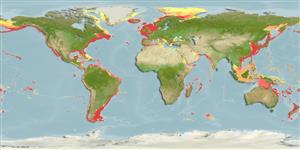Syllis cornuta Rathke, 1843
| Native range | All suitable habitat | Point map | Year 2050 |

|
| This map was computer-generated and has not yet been reviewed. |
| Syllis cornuta AquaMaps Data sources: GBIF OBIS |
Google image |
No photo available for this species.
Classification / Names Common names | Synonyms | CoL | ITIS | WoRMS
Polychaeta | Phyllodocida | Syllidae
Environment: milieu / climate zone / depth range / distribution range Ecology
Benthic; depth range 2 - 2560 m (Ref. 116516). Tropical; 27°C - 28°C (Ref. 87155)
Distribution Countries | FAO areas | Ecosystems | Occurrences | Introductions
Cosmopolitan. Tropical to polar.
Length at first maturity / Size / Weight / Age
Maturity: Lm ? range ? - ? cm Max length : 3.0 cm TL male/unsexed; (Ref. 75621)
Life cycle and mating behavior Maturity | Reproduction | Spawning | Eggs | Fecundity | Larvae
Main reference
References | Coordinator | Collaborators
Vittor, B.A. 2002 Gray's Reef benthic macroinvertebrate community assessment, April 2001. Final Report to NOAA under contract No. 50-DGNC-0-90024, NOAA NOS, Charleston, SC. (Ref. 3209)
IUCN Red List Status
(Ref. 130435: Version 2025-1)
CITES status (Ref. 108899)
CMS (Ref. 116361)
Threat to humans
Human uses
| FishSource |
Tools
More information
Max. ages / sizes
Length-weight rel.
Length-length rel.
Length-frequencies
Mass conversion
Abundance
Internet sources
BHL | BOLD Systems | CISTI | DiscoverLife | FAO(Publication : search) | Fishipedia | GenBank (genome, nucleotide) | GloBI | Gomexsi | Google Books | Google Scholar | Google | PubMed | Tree of Life | Wikipedia (Go, Search) | Zoological Record


